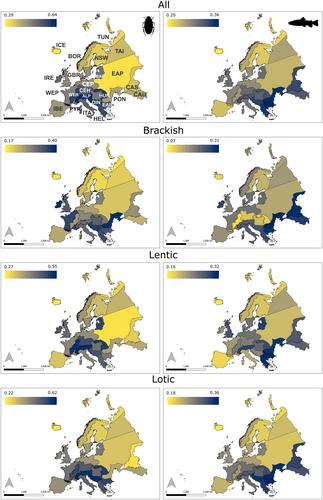Dispersal, glacial refugia and temperature shape biogeographical patterns in European freshwater biodiversity
Abstract
Aim
Temperature is regarded as an important driver of broad-scale biodiversity patterns. However, less is known of the role of dispersal in shaping broad-scale species and trait distributions, particularly given that species had to disperse out of glacial refugia after the Last Glacial Maximum (LGM). Here, we used a unique dataset describing the distributions of freshwater fauna combined with trait information to evaluate biodiversity relationships to distance to glacial refugia and temperature.
Location
Twenty-five biogeographical regions across Europe.
Time Period
Data from species occurrence were gathered in 1978.
Major Taxa Studied
A total of 2816 freshwater invertebrate species and 230 freshwater fish species.
Methods
Using the occurrence of invertebrate and fish species in the biogeographical regions, and publicly available trait information, we analysed patterns in diversity indices (i.e. species richness, trait richness and trait redundancy), trait distribution and species and trait β-diversity, and their relationship to distance to known glacial refugia and regional temperature.
Results
We show that distributions of European invertebrate and fish species and traits are primarily explained by distance to refugia and its covarying effect with temperature (i.e. refugia tend to be warmer). Specifically, species and trait richness were higher in regions proximate to refugia and lower in distant regions. Additionally, communities in colder and distant regions exhibited reduced niche dimensions and slower life histories, suggesting increased vulnerability to environmental change.
Main Conclusions
Species more distant from their refugia were characterized by higher dispersal capacities. Accordingly, since the LGM, only a subset of species was able to colonize distant regions, while many species have spatial ranges constrained by their dispersal capacity, increasing their potential for extinction under ongoing climate change. Therefore, additional conservation measures considering species' dispersal capacities are required.


 求助内容:
求助内容: 应助结果提醒方式:
应助结果提醒方式:


